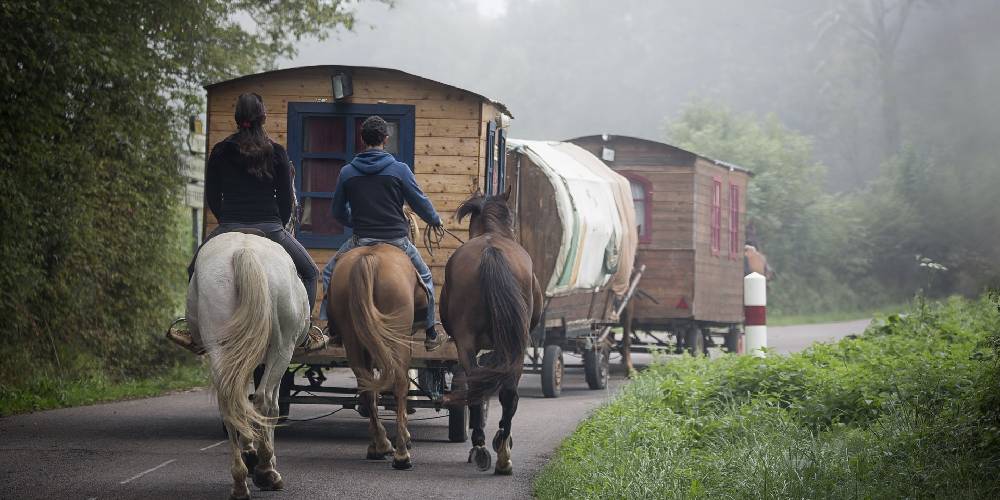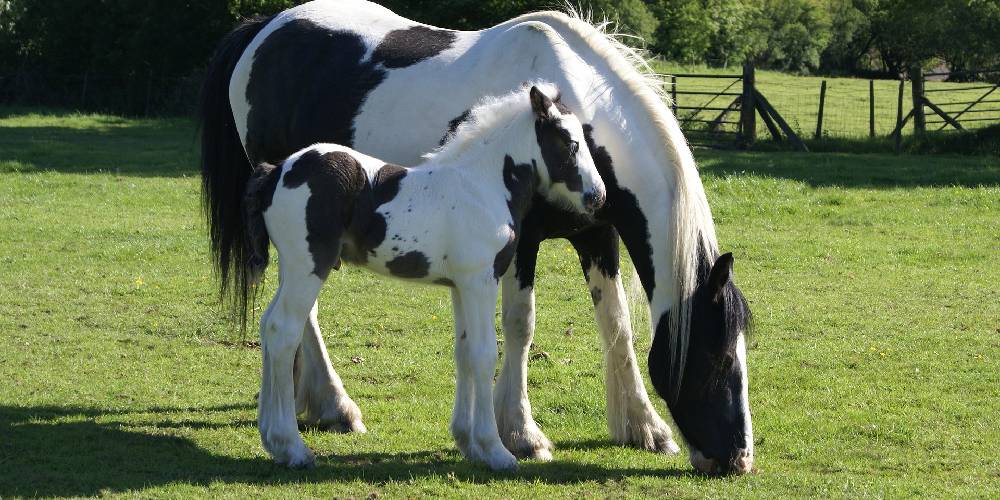The Gypsy Vanner is a breed that was developed in Ireland and Great Britain to be used for pulling and riding. This popular breed is highly demanded all over the world and people are willing to pay top dollar for these horses. What colors can these beautiful horses be? And what are they used for?
What Is The Gypsy Vanner?
The Gypsy Vanner is a European draft breed of horse that primarily originated in Ireland and Great Britain. This breed is known for its beauty and exceptionally long hair. Often seen in dressage classes and in-hand classes, the Gypsy Vanner is an exceptional show horse. These horses have great temperaments and can be used for almost anything. These horses were bred by the Gypsies to pull caravans, but can be ridden by anyone and, because of their gentle and kind personalities, they can even be ridden by children.
How Big Are Gypsy Vanners?
There are actually two versions of this breed, there is the Gypsy Cob and the Gypsy Vanner. The cob is just the smaller lighter version of the breed. The cob usually stands between 14.3 and 15.1 hands high and the Vanner stands between 15.1 and 16 hands high. This makes them an average size for horses, but a small size for draft breeds.
Because these horses are draft breeds they can weigh up to 1,700 pounds, but they can be as little as 1,100 pounds if they are a small cob.
What Colors Can Gypsy Vanners Be?

The Gypsy Vanner breed comes in any and all colors. This includes:
- Bay
- Black
- Gray
- Chestnut
- Palomino
- Buckskin
- Pinto (Including piebald, skewbald, overo, tobiano, and tovero)
- Perlino
- Cremello
- White
- Roan
Though Gypsy Vanners can come in any color under the sun, the most commonly seen is pinto, as piebald or skewbald.
The History Of The Gypsy Vanner

The Gypsy Vanner has a unique history compared to other breeds. These horses were bred and used by Gypsies to pull their caravans and wagons as they traveled from place to place.
This breed is descended from a number of draft breeds such as the Shire, Clydesdale, Dales Pony, and the Friesian. All of these breeds together created the Gypsy Vanner that we know today.
Through selective breeding of the offsping of these crosses, the Gypsies came up with a kind, strong, hard working breed that today is desired all throughout the world.
How To Identify The Gypsy Vanner
Legs
The legs of the Gypsy Vanner are good, sound and strong. They can help to identify the breed by the thick feathering that covers their lower legs. The horse also if frequently seen with white legs making their feathers a striking white.
Mane & Tail
Thanks to the genetics from the Dales ponly, the Gypsy Vanner has TONS of hair. Their mane and tail are often thick, long, and healthy and it is not unheard of for their manes and tails to touch the ground.
Coat
Their most common coat color or pattern is pinto making their coat an identifiable trait. It is uncommon to see a draft breed as a pinto, so it is likely that if you see one they are at least part Gypsy Vanner.
What The Gypsy Vanner Excels In
Pulling
The Gypsy Vanner was bred to pull Gypsy caravans across great distances. They also pulled carriages, carts, and wagons. Even today this breed is seen pulling just as they did a long time ago.
Dressage
Because of the breed’s striking appearance, elegance, and beauty, it is not a surprise that they are a popular choice for dressage. Not only does the breed have a beautiful appearance, but they also have a great temperament making them a good choice to display a horse’s obedience.
General Riding
These horses were frequently ridden by children in their past and today are only increasing in popularity as a riding horse. They make great pleasure riding horses because they are so easy going. Their growing popularity as a riding horse makes them in even higher demand than they were before.
How Long Do Gypsy Vanners Live?

The average lifespan of this breed is only about 20 years. One of the oldest known Gypsy Vanners lived to be about 27 years old which truly isn’t that old for a horse. This may be credited to their ties back to the Friesian breed who usually only lives to be around 16 years old.
Fun Facts About Gypsy Vanners
- This breed is only about 50 years old.
- Gypsies in Ireland and Great Britain bred certain breeds to get this horse.
- Its overall conformation is similar to their distant relative the Shire, though the Vanner is built smaller.
- The Gypsy Vanner can have a special marking known as a badger marking on their face. This marking is kind of like a reverse blaze where the horse has a white face and a dark stripe running down the front of its face rather than having the opposite for a true blaze.
FAQs On Gypsy Vanners
Why are Gypsy Vanners so expensive?
Gypsy Vanners are a highly sought after breed for their temperament, riding ability, color, and conformation. They are extremely expensive because they are in very high demand. The demand and cost goes up in the United States where even more people want Gypsy Vanner horses.
How much does the Gypsy Vanner cost in general?
Because of their rarity in North America, this breed, on average, can cost between $10,000 and $40,000 (USD) before training, registration, and conformation come into play. A registered and highly trained Gyspy Vanner can fetch you between $50,000 and $80,000 (USD) if not more!
Can Gypsy Vanners jump?
Yes, these horses can jump, but because they are so heavy it isn’t likely that they’ll be jumping very high or very fast as compared to lighter sport horse breeds. If your Gypsy Vanner likes it though, keep going!
Is there a Gypsy Vanner horse association?
Yes! There is in fact an association dedicated to this horse breed. It is known as the GHA or the Gypsy Horse Association. There is also a society dedicated to the breed known as the Gypsy Vanner Horse Society.

